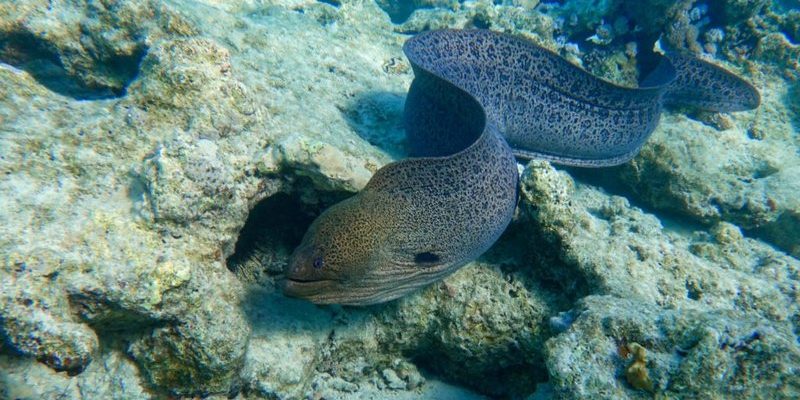
If you’ve ever been snorkeling or diving, you might have spotted one of these eels giving you a curious look. But there’s so much more to them than meets the eye. These fascinating creatures have evolved in some truly remarkable ways, adapting to their environments in ways that leave us in awe. So, grab a cup of coffee, settle in, and let’s dive into the underwater wonders of the moray eel!
1. Unique Anatomy: The Long and Short of It
Moray eels are instantly recognizable thanks to their elongated bodies. Unlike most fish that have a more compact shape, morays can reach impressive lengths—some species can grow over 13 feet long! Imagine swimming alongside something that long; it’s both awe-inspiring and a little intimidating, right?
Their bodies are designed for a life spent mostly in tight spaces. The lack of pectoral fins helps them navigate the rocky crevices they call home. Instead, they have a strong and flexible spine, allowing them to slither and weave through tight spots. It’s like having a built-in toolbox that’s perfectly suited for their environment.
Plus, their skin is covered in a slimy layer of mucus, which protects them from parasites and helps them move smoothly through water. Think of it as nature’s own wetsuit! This adaptation is essential for survival, especially since they live in complex environments filled with predators.
2. The Moray Eel’s Diet: A Carnivorous Hunter
Let’s talk about what these eels eat. Moray eels are carnivorous, primarily feasting on fish, octopuses, and even crustaceans. They’re not picky eaters, which is why you might find them snooping around various coral reefs looking for their next meal.
What’s fascinating is their method of hunting. Morays are often ambush predators. They’ll remain hidden in their rocky homes, waiting patiently until a fish swims too close. Then, in a flash, they strike! It’s kind of like a cat waiting to pounce on a toy mouse.
Moreover, moray eels have a second set of jaws called pharyngeal jaws, which help them grip and pull prey into their throat. It’s not something you see every day—imagine having two sets of jaws working together. This equipment makes them effective hunters, allowing them to consume larger prey than you might expect for their size.
3. Colors and Patterns: More than Just Looks
One of the more striking features of moray eels is their vibrant colors and unique patterns. You might see shades ranging from bright greens to deep blues, often adorned with spots or stripes. But here’s the thing—these colors serve a purpose beyond aesthetics.
In many cases, the coloration helps with camouflage, allowing them to blend in with their surroundings. Predator fish and larger threats can be hard to spot when you’re surrounded by the blues and greens of the reef!
Additionally, the different species have evolved various color patterns. For example, the zebra moray sports a pattern that looks strikingly similar to its namesake with bold stripes, while the green moray has a more understated, olive hue. It’s nature’s way of playing dress-up—a clever survival tactic for these remarkable creatures.
4. Habitat: Where Do They Live?
Moray eels can be found in warm tropical and subtropical waters around the globe. They prefer rocky or coral reefs, where they can find plenty of hiding spots. Think of these reefs as their bustling neighborhoods—full of nooks and crannies to explore.
Typically, you’ll find them at depths ranging from shallow waters to about 150 feet deep. While they’re often seen just off the coast, some species venture further out into the open ocean. Diving is a great way to see them in their element, but be sure not to disturb their cozy homes!
Interestingly, morays play a vital role in their ecosystems. By preying on smaller fish, they help balance populations and maintain the health of coral reefs. This means that their presence is not just fascinating; it’s also crucial for keeping the ecosystem thriving.
5. Social Behavior: Is There a Moray Eel Community?
You might be surprised to learn that moray eels aren’t the solitary creatures you might think they are. While they do spend a lot of time alone, some species have been known to exhibit social behavior, especially when it comes to mating.
During the breeding season, morays may be found in pairs, weaving in and out of their rocky homes. Here’s the thing: they engage in a unique courtship ritual that involves swimming together and even rubbing against each other. This dance isn’t just for show; it helps strengthen their bond and prepare them for spawning.
If you’re ever lucky enough to witness a pair during mating season, it’s a glimpse into their world that few get to see. Just think about it—seeing a side of their life beyond hunting and hiding can truly deepen your appreciation for them.
6. Defense Mechanisms: How Do They Protect Themselves?
While moray eels are fearsome hunters, they do have a few predators of their own, including larger fish and sharks. To protect themselves, they’ve developed several defense mechanisms.
First off, their sharp teeth are a significant deterrent. If a predator gets too close, they can deliver a painful bite. Think of it like a natural security system—they’re not going down without a fight!
Moreover, the slimy mucus layer we talked about earlier also plays a role in their defense. This slime can deter some predators and make them difficult to grasp. It’s like wearing an invisible cloak that rather annoys would-be attackers!
Lastly, their tendency to hide in crevices provides excellent camouflage, allowing them to escape notice. When you think about it, it’s a clever combination of looks and strategy that helps them survive in a hostile underwater world.
7. Reproduction: The Mysteries of Moray Eel Mating
The reproductive habits of moray eels can be quite the mystery. They are oviparous, meaning they lay eggs. During the spawning season, a female moray eel can release thousands of eggs at once! Just imagine that number—it’s practically a mini-explosion of new life.
Interestingly, they don’t provide care for their young. Instead, once the eggs are laid, they’re left to develop on their own. The hatchlings are tiny versions of their adults and must fend for themselves from the moment they enter the water.
This lack of parental care can be a tough start for the little eels, but it’s a survival strategy. With so many offspring, even if many don’t survive, a few will grow up and carry on the species. It’s the circle of life, right?
8. Conservation Status: Are Moray Eels at Risk?
While these fascinating creatures play crucial roles in their ecosystems, their populations are facing some threats. Overfishing, habitat loss, and climate change are putting pressure on moray eel populations around the world.
Many species of moray eels are considered vulnerable, and their numbers are declining in certain areas. The main reason for this decline is overfishing, as they are often sought after for their unique appearance or harvested for aquariums.
Conservation efforts are essential to protect these eels’ habitats and ensure their survival. Supporting sustainable fishing practices and protecting reef habitats can go a long way in helping morays thrive.
Moray eels are truly one of the ocean’s hidden treasures. From their unique anatomy and vibrant colors to their fascinating social behaviors, they remind us of the wonders that lie beneath the waves. Understanding their role in the ecosystem is vital for conservation efforts, making it essential to protect these curious predators.
Whether you’re an aspiring marine biologist or just a curious soul, moray eels inspire awe with their adaptations and behaviors. Next time you’re near a reef or watching a documentary, take a moment to appreciate these extraordinary creatures. They’re not just fascinating to observe; they play a crucial role in maintaining the health of the ocean. Let’s work together to ensure they continue to thrive for generations to come!

